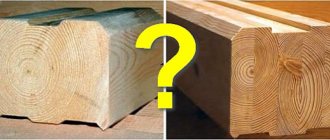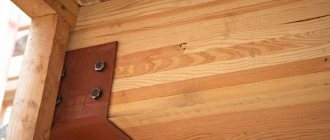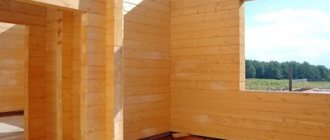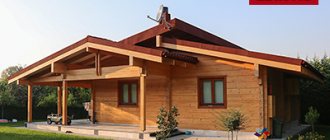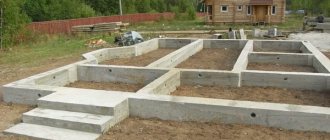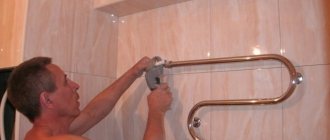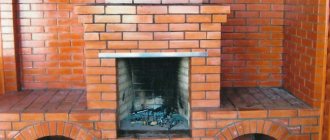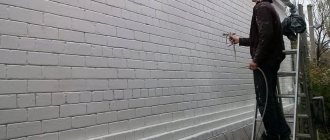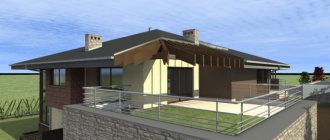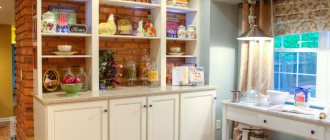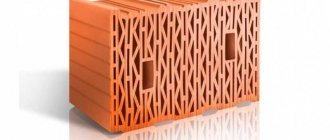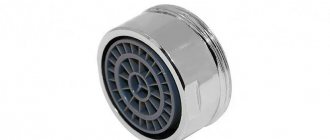Nowadays, new building materials are not so rare on the market.
Various new products are appearing in construction more and more often. The creation of environmentally friendly, relatively inexpensive and reliable materials is the main direction in the activities of builders and inventors. They created wooden bricks.
What is this, wooden brick?
What is he?
Ordinary brick immediately comes to mind, but this building material is similar to ordinary brick only in name and slightly in shape. In fact, the closest “relative” of wooden brick is wooden beams, only smaller in size.
It is rather a wooden block measuring 65 x 19 x 6 cm, on the sides of which there are special locks for fastening.
For its production, high-quality coniferous wood is used, subjecting it to a number of operations: drying until a moisture content of 8 to 10% is reached, mechanical processing of all surfaces of the block, and final grinding.
The result is a product that, in principle, does not require any further finishing. Walls made of sanded wood and without finishing look good, but to protect against precipitation and other influences, it is still wiser to apply some kind of protective coating.
ADVANTAGES OF WOODEN BRICK
Houses made of wooden bricks do not have all the disadvantages that appear in houses built from wood of natural moisture, and also have environmental advantages over laminated timber.
Wooden brick has no deformation, shrinkage, or wall cracks. Wooden brick has a high surface quality comparable to furniture quality.
Dry wooden brick has less weight than material with natural moisture. This fact makes it possible to simplify the design of the foundation and seriously reduce the costs of its construction.
The small weight and size of wooden bricks makes it possible not to use cranes, forklifts and heavy equipment during transportation and on the construction site.
So, do wooden bricks have no disadvantages at all?
Alas, of course, this is not the case.
You cannot start construction without a well-developed project, otherwise the walls may simply fall under the influence of loads. It is also not recommended to build multi-storey buildings and large houses from it - such structures will be unstable. Well, if your region has a harsh climate, then wooden bricks simply won’t suit you - the house will turn out to be quite cold.
Many home craftsmen will ask themselves the question: is it possible to make such wooden bricks at home?
Experts are quite skeptical about such an initiative. After all, there are many specific and quite high requirements for the material, and even for the product itself, which are very problematic and sometimes even impossible to meet in a home workshop. And the plant has high-precision milling and grinding equipment.
Professionals are only allowed to lay wooden bricks themselves, but with the obligatory observance of the following rules: the brick is laid in a row; compliance with the order is mandatory; the block is laid edgewise on the lock; Both the outer and inner rows require transverse ligation every 3 blocks.
In this case, the dressing material is the same as the one from which the masonry is made; the matching of the dressing with the bricks of the bottom row is not allowed. It must be regularly shifted by 0.5 bricks.
Useful tips
To make a high quality epoxy table, it is recommended to follow some rules:
- The resin hardens poorly in high humidity. Condensation may penetrate from the air. To prevent this unpleasant phenomenon, you can hang a film over the tabletop.
- The mixture will harden faster if the tabletop is placed on the radiator. You cannot heat from above, as the surface may become uneven. You need to prepare personal protective equipment - a respirator, goggles and gloves.
- Exposure to ultraviolet rays may cause the countertop to turn yellow. All horizontal surfaces in the “resin affected” area must be covered with polyethylene. If the bubbles do not come out well, it is recommended to warm the surface with a hair dryer or inject acetone from a spray bottle.
These manipulations will reduce surface tension. If you follow all the recommendations and follow the technology, you can quickly master the manufacture of original tables. At the same time, your favorite business can begin to generate income.
woodschool.ru
slabdoska.ru
Below are other entries on the topic “How to do it yourself for a homeowner!”
- DIY zipper bracelet (PHOTO + STEP-BY-STEP DESCRIPTION)HOW TO MAKE A BRACELET FROM REGULAR…
- Do-it-yourself garden rack (photo and drawing)How to make a rack in the garden…
- Do-it-yourself drilling machine (+photo)How to make a drilling machine with your own...
- Very beautiful do-it-yourself wooden bracelets (photo) Elegant DIY BRACELETS without a machine...
- Do-it-yourself Lego constructor from wood How to make a wooden Lego And boys,…
- Do-it-yourself owl made of wood - for keysDo-it-yourself owl key holder made from...
- Do-it-yourself rug made of “wood” How to make an unusual wooden rug This…
Today, no one can be surprised by innovative building materials.
Every year experts release some new product to the market. Recently, in the construction industry, everyone has also started talking about the need for environmentally friendly products. And the result was not long in coming.
Russian specialists have released a relatively inexpensive and at the same time reliable material that does not harm the environment. This is a wooden brick. It has already been appreciated and is being used in construction.
Wood brick: what is it?
It must be said that this innovation is similar to ordinary brick only in its shape and name. In fact, a “relative” of this product is timber, but with smaller dimensions. In appearance it is a block with dimensions 650x190x60 cm.
For ease of use, special locks are made on the sides of each brick for fastening.
To make wooden bricks, only high-quality coniferous wood is used. During production, it goes through several operations.
First of all, the raw wood is dried until the moisture content reaches 8-12%. Then mechanical processing of all side surfaces is carried out. The final stage is sanding.
The result is a building material that no longer requires any additional finishing work.
This is a profitable solution. If you build a house from such blocks, you no longer need to finish the facade - it already looks great. It will be enough to apply a layer of wax as protection from the external environment and moisture.
In addition to standard sizes, individual wooden bricks are also produced. The block can be of any size as desired and necessary.
Preparing the premises
Before starting repairs, it is necessary to clean the room, remove all dust and construction debris, preferably wet cleaning. After which the insulation procedure is carried out. Next, precise measurements are taken, taking into account all the architectural features of the room. This is done for subsequent calculation of the amount of materials and drawing up an estimate. Their presence will allow you to save money if there is no balance, or eliminate the need to purchase additional materials. The easiest way to count the number of square tiles is with the direct installation method. To do this, you need to calculate the surface area, divide it by the area of one tile. Also take into account the thickness of the grout joint (from 2 to 10 mm) and 10-15% of the material for the breakage. To calculate the number of rectangular tiles, when using decorative ones, when laying diagonally, it is better to use a construction calculator.
Square tiles are easy to calculate
Benefits of Green Innovation
When this building material was created, the inventor of the product solved most of the problems that arise during construction work on the construction of wooden houses.
So, houses made of wood take several years to make - you need to wait until the structure dries out. Then they wait for it to shrink. Next, doors and windows are installed.
And only after this the builders begin finishing work. Using a new innovative material, you can safely skip the stages of drying and shrinkage. An environmentally friendly building is ready for use immediately after construction.
In addition, wood blocks do not deform during the drying process - they have small dimensions. As a result, the original shape of the blocks is perfectly preserved, and the products themselves are perfectly connected to each other. In this case, you can forget about the gaps - there are none.
Another advantage of this know-how is the low cost of construction if wooden bricks are used. A structure built in this way costs much less due to the absence of the need for expensive equipment for carrying out the work, sealants, cement and sand, as well as the absence of the need for further processing with plaster. The most expensive parts to build will be pillars and crowns.
Naturally, you can build an excellent eco-house without them, but no one wants the building to suddenly collapse. If you want to get a reliable building, then you can use laminated veneer lumber. It is cheaper, and the result is no worse than with a solid pole.
Designers do not limit the overall dimensions of bricks, as is the case when logs or beams are used. Thus, this building material allows you to create even the most unreal and amazing architectural elements on its basis.
And finally, the price of wooden bricks is several times lower than the cost of laminated veneer lumber. This is definitely an important advantage.
Working draft
For clarity, let me present a working draft. Bathhouse size 35000*55000mm with a relaxation room, washing room and steam room. In creating the project, many years of experience and skills in working in AutoCAD were used. 185 standard parts were modeled in the “solid-state” program environment. Based on them, a structure was assembled in the same environment from 4553 parts. The structure is fastened with cable tensioners in the hollow space of the walls to anchors in the foundation. The accumulated volume is 329 MB in 245 files. I show four types of models below:
Flaws
This material has many advantages.
But potential buyers should be warned about some of the disadvantages that wood brick has. In regions with a harsh climate, it is better to build a house from traditional brick - a wooden house will not work in this case. It will be too cold there.
It is also not recommended to build multi-storey buildings from eco-bricks, which have a large area - there will not be the necessary stability.
You should not start construction work without a project developed by competent specialists. A house made of such building material, made without a design, can collapse under the influence of even minimal loads.
Masonry rules
There is an opinion among professionals that one cannot cope with the process of laying this building material on one’s own. This is debatable. There are a number of rules that must be followed.
So, the brick must be laid strictly in order. Be sure to follow the order. The block is placed edge-on to the lock.
Transverse ligation is required for external and internal blocks. This is done every three blocks. Moreover, the dressing material should be the same as the masonry itself.
The dressing must not be allowed to coincide with the parts from the bottom row. It should be shifted by 0.5 bricks. This is the only way to get a reliable structure made according to all the rules, as well as a beautiful pattern of natural wood and a hollow wall.
A layer of thermal insulation is placed between the outer and inner walls. In rare cases, you can add sawdust there. They also have excellent heat retention properties.
We are building a modern house
Specifications
The description of the material suggests that this is a fully thought-out type of brick, which is made with great attention to detail:
- The brick is made from solid timber, and the wood is always perfectly dried.
- The block is equipped with special locks on each of the four sides.
- The wood is sanded to a very high quality and this allows you to avoid gaps in the seams and uneven joints when joining.
- The standard size of the bar is 19x6x65. However, other sizes can be pre-ordered.
Pros and benefits
Wood itself speaks of the advantage of a natural material, especially considering that coniferous species such as pine, spruce, cedar, and larch are used in production.
In addition, we will highlight the following points:
- Resistance to deformation . This state is achieved thanks to the locks on the brick and if, for example, double sand-lime brick m 150 requires mortar, then the wooden material is simply tightly connected to each other.
- Thermal insulation . Wood is a natural heat insulator, so the house retains heat perfectly.
- Free air exchange . The natural properties of wood come in handy here too!
An important point is the cost, for example, a cube of such material costs up to 2 times less than a similar volume of laminated veneer lumber.
Bar walls
Important! For lovers of architectural delights, working with such a block will be simply a treasure trove of finds! Almost any architectural solutions can be used and all of them will be implemented in construction.
Of course, it will not be possible to completely build a house using only wooden bricks; we will still need rigid structures and the use of other building materials, but we can take a block of wood as a basis.
What can be built
Let us now turn to the practical side of the issue. Recently, wooden blocks have become increasingly popular in the suburban construction of low-rise buildings.
This is easily explained by several basic construction observations:
House made of bars
- First of all, the weight of the material allows you to design a house with foundation parameters different from brick, and this is not just a reduction in the overall cost, but also a simplified construction option.
- Simplicity in “laying” allows you to carry out almost all the work yourself, without resorting to special techniques or equipment.
- Such a house, unlike a brick one, will not require a long period of shrinkage; the wood is initially dried so much that there can be no question of deformation of the walls and window openings.
Thus, it turns out that we can build load-bearing walls and interior partitions from wooden blocks in the form of bricks, that is, almost everything!
Moreover, external walls will not necessarily require even additional insulation, although this point must be accurately calculated and the level of expected heat loss must be determined, and on this basis a decision on insulation must be made.
Basic nuances of masonry
By the way, masonry with wooden beams is somewhat different from what we use if we have simple building bricks and mortar. One might even say that the masonry is the main point in the entire invention.
Castle masonry
We lay out all the details of the structure in a strictly orderly manner, and we will continue to adhere to the order in the future. We place the block on the edge, butt to butt.
Every three bricks we make a transverse bandage of the outer and inner rows. It is important to note here that the dressing is made with the same material, from the same wood.
Important! The dressing should not coincide with the bricks in the bottom row. To do this, we constantly shift it by half a brick, but at the same time we get an increase in strength.
The masonry scheme allows you to overlap layers and orders by half a brick, and we get the correct design, compliance with a beautiful ornament, a hollow wall that fully meets all the technical requirements of the masonry.
Cavity walls
When constructing the walls, we got a cavity between the outer and inner rows of the wall, these are the features of the masonry, and the moment of thermal insulation. Insulation can be placed in the cavity. We have already touched on this point when talking about calculating heat loss.
However, even if you do not use external or internal insulation, you can insulate the wall somewhat. Simple wood shavings and sawdust are poured into the cavity.
Block masonry
The choice is due to the fact that this is the same natural element as the bars themselves, and accordingly, sawdust will not only enhance the thermal insulation properties of the walls, but also enhance natural air exchange.
In this case, the air from the premises will be removed through the wooden walls and replaced with fresh air from the street. A natural process that cannot be obtained with other materials.
Finishing
Exterior finishing can only include wood protection, for example. You can cover the walls with wax or another protective layer, but there is no point in applying plaster, this will only spoil the appearance and hide the stunningly beautiful structure of the wood.
When finishing, instructions for working with wood may suggest soaking the walls with antiseptics and fire-fighting solutions, which will reduce the risk of wood fire.
Finishing
Inside the house, in most cases, there is no need for finishing at all, as great as walls with wooden blocks look.
Where are wooden bricks made?
There are several enterprises in Russia that produce this construction know-how. So, brick is produced in St. Petersburg, in the same place where it was invented. It was in this city that this innovation was created on the basis of the Stankom company.
You can see the first houses in the construction of which the material was used. These buildings are located in Zaozerye, Zaychikhino, and in the village of Harmony. The company produces products under the Woodbrick brand.
Another enterprise is located in Tomsk. Pine products are produced there.
The product is supplied under the “Cozy Home” brand. This is what these wooden bricks look like. The photo can be seen below. The price of these eco-friendly building materials is significantly lower than that of Woodbrick.
Reviews and prospects
This material has good prospects, however, it is only suitable for low-rise construction. Professionals say that this material is suitable for those who already have a house and additionally want other buildings on the site.
The second point is the price. Manufacturers are not very willing to share information about them, but the cost of material from “Cozy House” is $470 per 1 cubic meter, while profiled timber with the same size can be bought for $320, rounded logs for $240. “Stinkom” offers products of the same size “A” for 860 dollars, and laminated veneer lumber for 600.
There is another problem that wooden bricks have. Reviews indicate a large deviation from tolerances.
The size must be strictly maintained to hundredths of a millimeter, especially on locks. A large number of connecting surfaces can turn a building into a sieve if the gaps are too large. The locks are connected either with serious play or with the help of a hammer.
Kitchen glass holder
Published 07/20/2018
At first glance, you wouldn't think that this cute glass holder is made from scrap wood. But that’s exactly how it is, I’ll tell you how to make the same in this instruction.
Wooden bricks: raw technology
Such a wall, in which there are an abundance of gaps and mechanical stresses, will sooner or later crack.
More cracks will appear. There are still a lot of problems in this technology that have not been solved. It hasn't been fully worked out yet.
Those advantages that manufacturers talk about in advertising brochures are still only wishful thinking rather than reality. Here it is, an innovative wooden brick. Like glass, it can be waterproof only if all installation rules have been followed.
Today, a fairly new, but quite popular material for the construction of residential buildings is wooden brick. This is a prime example of excellent value for money.
The range of building materials has been updated very frequently recently. Manufacturers are trying to take into account the wishes of customers, so more and more environmentally friendly building materials are appearing from which a house can be built.
The cost of production also plays a huge role. In conditions of fierce competition, we have to come up with eco-materials at an affordable price. These are the products that are in greatest demand among the general consumer.
Benefits from a home workshop
Such events are conceived only for economic benefit and it is not difficult to calculate. This can be done in a very simple way. The average weight of the block is 20 kg. If we convert all the material used into tons, it turns out that 1 ton of cement, 2 tons of sand, 4 tons of filler were spent on a conventional production cycle. This amount of product will require 6 kg of plasticizer, which will cost 300 rubles. As an example, a building block made of crushed stone is given.
Cost of consumables:
cement 1 ton – 5000 rub.
sand 2 tons – 800 rub.
crushed stone 4 tons – 2400 rub.
plasticizer 6 kg. – 300 rub.
The total cost is 8,500 rubles.
This amount will yield 6 tons of finished products or 300 blocks. The cost amount of 8500 must be divided into 300 blocks, which will give the raw material cost per unit of goods. Thus, the raw material cost of the block amounted to 28.3 rubles. 1.7 rubles should be allocated for energy costs.
Features of wooden bricks
What is called wooden brick resembles a standard building material only in its convenient shape.
Otherwise it is pure wood that has been cut to a specific size. That is, to make wooden bricks, a wooden beam is cut, and then it is used for laying walls. In appearance, it is a wooden brick block, but always with special locks with which installation is carried out.
Most often on sale you can find wooden bricks made from softwood.
At the same time, the wood must undergo certain processing, after which the brick becomes so durable that it is ideal for many situations in the construction of houses. It is worth noting that the material is thoroughly dried so that its moisture content is no more than 10%. In addition, the surface must be mechanically treated and thoroughly polished.
The result is an excellent building material that is not only environmentally friendly and durable, but also very convenient to use. Finished walls made of wooden bricks do not require additional processing.
The facade and interior of the wall will look just great. If desired, you can use additional finishing materials, but this makes no sense, since the look of natural wood is always relevant. This is a classic that always looks great.
The peculiarity of wooden bricks is that, if necessary, the buyer can order any format. If the construction project requires this, then you can order from the manufacturer exactly the form that will be most suitable.
Material characteristics
The powder obtained by grinding sawdust has a fraction of several microns, although flour with larger particles is sometimes found. The color of recyclable materials directly depends on the type of wood from which it is obtained. In most cases, the material is light amber or chestnut in color. The first option is characteristic of coniferous wood, which has a light-colored fiber. Depending on the grade of wood flour, it can be used in the production of phenolic plastics, building materials, various compounds (including for the chemical industry), filter elements and carpentry adhesives. This material is characterized by excellent hygroscopic properties, is easily packaged in any convenient container and does not change its physical parameters under the influence of external factors. Considering the fact that recyclable materials of this type easily absorb moisture, it is customary to transport and store it in thick plastic bags.
Requirements for raw materials
The production of wood flour can be based on a wide range of materials, the main thing is that they are all of natural origin and completely free of metal elements. If products are treated with chemical fire retardants or antiseptics at a furniture or woodworking plant, then the waste accompanying their production is not used to obtain wood flour. As for the forms and fractions of the feedstock, they can be completely different. Wood chips, sawdust, shavings, scraps and wood fragments are suitable for putting into shredders.
The highest quality flour is obtained from the waste of freshly cut trees that have undergone a drying procedure. The characteristics of the feedstock directly affect the application of the finished product. For example, in the production of electrode cellulose, it is possible to use low-grade wood flour, while at the same time, the production of components for construction adhesive compositions requires high performance qualities of raw materials, and only high-grade material is suitable here.
Pros and cons of wooden bricks
With the appearance on the market of building materials such as wooden bricks, many craftsmen immediately solved several problems. First of all, it is worth noting that in this case there is no need to wait a long time for the wooden structure to stand and shrink.
As a rule, when a log house is built, this is exactly what happens. A house made of wooden bricks will not shrink, so you only need to install windows and doors, after which you can begin finishing work. Most often, they are carried out only from the inside, and from the outside, the most that would be appropriate is the use of wax.
Wooden houses made of this material are dry, they are not subject to deformation, so you can immediately move in and live in them. Moreover, such a building material is cheaper than many others and does not require the use of special equipment and various additional materials, such as sealants and plaster mixtures.
If a master is going to build a house from wooden bricks with his own hands, he needs to be prepared to purchase rigid pillars that will be the main building. Without them, the house can simply fold up like a card house. Most often, laminated veneer lumber is used for this, which is characterized by its high strength and inexpensive price.
But this option also has several disadvantages - this concerns the fact that the house is not very warm. Therefore, wooden bricks are not suitable for the construction of buildings in harsh climates. In addition, experts do not recommend building large and multi-story buildings from building materials of this type, since the block-brick may not withstand such a load.
Nevertheless, this type of building materials is widely used in our time, including for the construction of buildings with their own hands. Wooden brick is ideal for the construction of small residential houses and cottages, as well as gazebos, fences, and partitions in the apartment.
Let's start installing tiles on a wooden wall
- First of all, you need to use any antiseptic in order to protect your wooden walls from rotting. Since wooden walls can absorb moisture, this is a very important point; do not neglect the use of antiseptic!
- Afterwards you need to glue the roofing felt to the wooden wall. It will protect the tree from destruction. During the drying process, the cement mortar releases moisture, therefore, if you do not protect the wall with roofing felt, it will absorb all the moisture, thereby causing the formation of fungus or mold.
- Next, at a short distance from the wall, you need to mount a metal mesh, which will serve as a reinforcing material and will prevent your wall from crumbling. To install the mesh at a distance from the wall, it is advisable to use slats. This way you will give the wood the opportunity to breathe without destroying your structure.
- Afterwards, you need to roll the entire wall into cement mortar. Be sure to use cement mortar and not gypsum, otherwise you may have problems with the wall in the future. After applying the solution, it must be allowed to completely harden. Moreover, it is advisable to periodically wet the wall with water for three days so that the cement becomes as strong as possible.
- Next, we move on to the work of cladding a non-wooden wall.
- Before starting work, it is advisable to soak the tiles in water for 5 hours. Tiles soaked in moisture will have better adhesion, which will significantly increase their chances of durability.
- Be careful, because sometimes due to a violation of the tile production technology, stains may appear on it when soaked. We recommend testing one or two tiles before soaking the entire material. Those tiles on which stains appear must be returned and replaced. If you don’t want to take risks, use a spray bottle with water and simply wet the inside of the tile.
- The main thing when facing is to do everything smoothly. In simple terms, the first tiles set the vertical and horizontal of the entire future cladding. Therefore, use a bubble level or laser level to correctly lay out the first tiles.
- When laying tiles on the wall, use crosses to ensure that the width of the joints between all tiles is the same. At least two crosses are installed on each tile. It is advisable to install along the edges of the tiles to avoid accidentally bevelling.
- The solution must be laid on the inside of the tile, leveling it with a comb or trowel, and then apply the tile to the wall.
- If excess mortar appears along the contour of the tile, simply remove it using a scourer.
- After the solution has completely hardened, it is necessary to remove all the crosses, clean the horizontal and vertical seams, and then fill the solution with plaster, or better yet, with a special grout for tiles.
What you need to know about working with wooden bricks?
If a master is going to build a house, he needs to draw up a design for the building. Based on this, the type and size of the wooden brick will be selected.
The material can be ordered from professional manufacturers or made by yourself. But the latter option is quite complex and requires special knowledge and equipment. Therefore, it will be much more convenient and cheaper to simply order a suitable brick at the factory.
Working with this material is very simple, but the master must have some knowledge in the field of construction. The brick must be laid correctly, that is, observing all the requirements for working with this material.
When building the walls of a house, it is necessary to lay bricks in rows - this is the most important condition, since without order the wall will not be strong enough.
The blocks must be laid edgewise on the lock. Every three blocks a transverse ligation is needed.
If the wooden bricks are installed correctly, there will be a small gap between the inner and outer walls. It is suitable for thermal insulation. In the case of wooden bricks, sawdust is the ideal option.
But in any case, even with the best thermal insulation, such houses turn out to be quite cold. Therefore, it is not recommended to build them very large, especially in those regions where there are severe frosts.
Date: 01/21/2015 Comments: Rating: 14
In the vast world of building materials, something new is constantly appearing. Scientists and inventors are working to create new materials and technologies for their use. Brick, concrete, and wood are traditionally used to build houses.
Everywhere you can find buildings built using wooden beams and rounded logs. But many have not even heard of the building material called wooden brick. This new ingenious and simple invention can already be purchased and used for its intended purpose. To do this, you need to know its purpose.
A house made of wooden bricks can be built quickly using special fastening locks.
Wooden bricks invented by Russian engineers are a kind of small beams.
They have fastening locks of a special design, which allow you to quickly assemble the walls of buildings in much the same way as children assemble them using wooden construction kit parts. During the manufacturing process, wood bricks are processed to perfect condition. Walls from it can be assembled without the use of any sealants or inter-crown insulation.
Poor floor condition
Preparing the base before laying tiles If the structure is severely damaged, there are two scenarios:
- complete replacement of the wooden floor (flooring and joists);
- removing the floor and pouring the concrete screed.
The second option is best suited for houses with reinforced concrete floors. The first is considered in the case of wooden buildings. Screed is preferable because such floors do not cause problems over time.
As the wood ages, defects such as creaking, rotting, and sagging will reappear. But if tiles are laid on the floor, it is not easy to remove them; serious repairs will be required with labor-intensive removal of the floor covering.
After replacing the base with a wooden one, work is carried out as if the floor is in good condition, starting from point 2. If the decision is made to pour the screed, installation is carried out using the appropriate technology.
